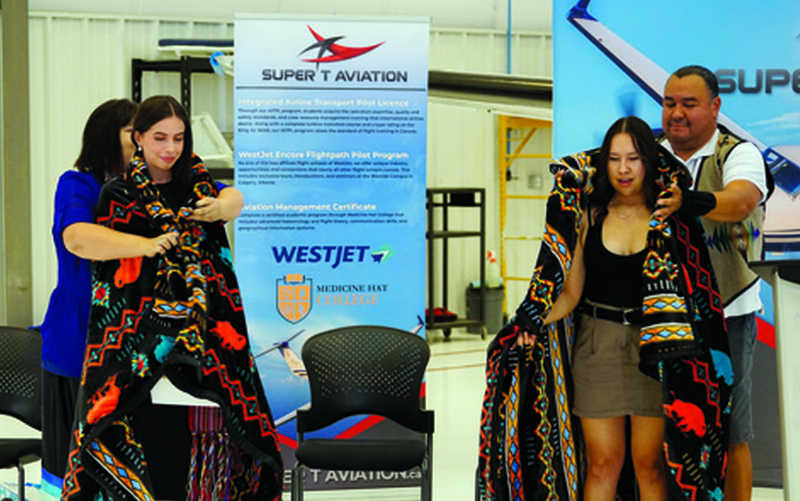
Features
Training
First Nations flyers get their wings
September 6, 2022 By By Samantha Johnson, Local Journalism Initiative Reporter, Medicine Hat News
 Graduating students get blanketed. On the left, Chasity Cairns blankets Megan Lessard, and on the right David Restoule blankets Cheryden Moberly. The blankets have buffalo images on them, which represents education for Indigenous peoples. (Photo: Samantha Johnson)
Graduating students get blanketed. On the left, Chasity Cairns blankets Megan Lessard, and on the right David Restoule blankets Cheryden Moberly. The blankets have buffalo images on them, which represents education for Indigenous peoples. (Photo: Samantha Johnson) Megan Lessard and Cheryden Moberly defeated the odds Friday by receiving their first set of wings at Super T Aviation.
Lessard, 19, had butterflies in her stomach in a good way and is excited for what life is going to bring next. Moberly, 21, feels she is just getting started and is excited to see what happens next.
Terri Super of Super T Aviation explained both graduates are from First Nations Technical Institute. Both students came to Medicine Hat after the hangar and all 13 training planes at FNTI were destroyed in a fire back in February of this year.
MLA Drew Barnes said, “hats off to Super T and everybody who works in this area. To the two graduates, on a personal level I am so envious. You guys have the ability, the courage and the opportunity to see the world from 10 or 30,000 feet.”
Leading the cultural part of the ceremony and bearing gifts were David Restoule, Indigenous student specialist, and Chasity Cairns, manager of Indigenous Engagement and Student Supports, both from Medicine Hat College. Both expressed how honoured they were to be part of the ceremony and how proud they were of the graduates.
The first gifts were a sash for Lessard and a medicine pouch for Moberly. Afterwards both women were blanketed.
“Today as Indigenous people education is the buffalo,” explained Cairns. “Without an education we can’t provide all the necessities we need. The buffalo represents education and your accomplishments. In our culture, we blanket people when they have accomplished something or for a rite of passage.”
Both blankets were identical and had images of buffalo on them.
Lessard lives in Timmins, Ont., and is part of the Métis Nation of Ontario. She picked up an interest in aviation while doing a co-op program at Air Quebec in high school. Her goal is to give back, “many northern communities are only accessible by plane and many pilots don’t want to work up there. I would love to give back to those communities by doing something I enjoy.”
Moberly is from Wabaska, Alta., and spent half her life there and half living in the city. She started her post-secondary education at NAIT in business and administration but realized after a semester it wasn’t the right path. Through her father, who knew she had an interest in becoming a pilot, she found out about the FNTI aviation program.
Both Moberly and Lessard will pursue their commercial rating next. In the long term Lessard is looking toward to becoming a Medivac in Northern Communities and Lessard wants to get her float rating.
For Lessard flying is “such a great feeling. It’s really freeing and makes you realize how big the earth is. You get to fly over everything, and you see so much.”
Moberly finds flying liberating and fun: “I’ve had some ups and downs throughout my training but whenever I’m up there I feel free.”
Moberly also discussed how it’s important for people to know she is First Nations Cree and feels she is part of an unrepresented minority, especially in modern days.
“It’s been a lifetime thing trying to connect back to my culture. I was raised half my life in the city, and it takes a piece of your identity if you aren’t surrounded by your family, the native language and food. It’s hard to access cultural programs outside your community.”